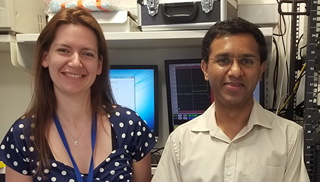Columbia University
Irving Medical Center
Neurological Institute
710 West 168th Street, 3rd floor
(212) 305-1818
Featured Research
Columbia University Alzheimer's Disease Research Center (ADRC) 2018-19 Pilot Grant Awardees
(in alphabetical order)

Jorge Montesinos Selfa, PhD
Jorge Montesinos Selfa, PhD
Postdoctoral Research Scientist, Department of Neurology, Division of Neuromuscular Medicine, Columbia University Irving Medical Center
Role of C99 in Lipid Dyshomeostasis in Alzheimerās Disease
The lipid composition of neuronal membranes is intimately related to the neuronās function in the regulation of ion gradients, and neurotransmission. During these events, membrane lipid composition changes so as to modulate membrane properties and the function of the proteins embedded therein. Once these changes occur, a network of lipid pathways acts in concert to maintain lipid homeostasis. To facilitate this crosstalk, key regulatory enzymes converge at unique cellular domains that act as functional platforms for the control of the cellular metabolism. One such regulatory platform consists of endoplasmic reticulum (ER)-membranes associated with mitochondria, or MAMs.
Mounting evidence in Alzheimerās disease (AD) support the role of lipid dysregulation and MAM alteration including cholesterol metabolism and membranes permeability in the pathogenesis of the disease. But the reason for these disturbances and their significance in the disease is not yet understood. Relevant to this, we have found that C99, a product of APP processing, is localized in MAMs, where it undergoes cleavage by Ī³-secretase to generate b-amyloid. Our data further show that elevated levels of C99 in MAMs correlate with the dysregulation of cholesterol and sphingolipid regulation (Pera et al., 2017). We propose that C99 contributes to the regulation of MAM physiology, and that alterations in the levels of C99 in MAMs provoke lipid imbalance that disrupts the composition and function of cellular membranes during the pathogenesis of AD.
Our goal in this project is to understand the mechanistic relationship between MAM activity, C99 production and localization, and the alteration in the lipid composition of neuronal membranes in cell models of AD.

Yasir H. Qureshi, MD
Yasir H. Qureshi, MD
Postdoctoral Research Scientist, Taub Institute for Research on Alzheimer's Disease and the Aging Brain, Columbia University Irving Medical Center
Retromer Viral Vectors for Alzheimerās Disease Gene Therapy
Recent genetic and cell biological findings in Alzheimerās disease (AD) have implicated āendosomal traffickingā as playing central role in disease pathophysiology. Retromer is a protein assembly that has emerged as a āmaster conductorā of endosomal trafficking, and a range of studies have linked retromer defects to AD. Based on previous studies and our preliminary data we hypothesize that overexpression of a single retromer protein in the mammalian brain will enhance retromer and endosomal function and will ameliorate indicators of AD. We will begin in cell culture systems to identify which of the three retromer core proteins (Vps35, Vps26, Vps29) and which molecular tag (HA or GFP) or lack thereof, best enhances retromer and endosomal function. Once identified we will package the optimal construct into an AAV9 system and inject into the mouse hippocampus and test whether we can enhance retromer and endosomal function in the living brain, and ameliorate indicators of AD.
The ultimate goal of this proposal is to develop an AAV9 viral vector system that when injected into the mouse brain will reliably enhance retromer and endosomal trafficking function. We believe that this technology will have high impact for two important reasons. First, while most studies have linked retromer to AD by showing that worsening retromer function worsens indicators of AD, few studies have shown the opposite in the living mammalian brain. Namely, few studies have shown that enhancing retromer function enhances endosomal trafficking function and ameliorates indictors of AD. This proposal sets out to optimize a technology that will allow this to be tested. If confirmed, this proposal will therefore strengthen the mechanistic and causal link between retromer/endosomal function and AD pathophysiology. Second, if successful, this proposal will provide the first proof-of-principle for the idea that retromer viral vectors might be developed for AD gene therapy.

Danique Jeurissen, PhD and Shushruth, MBBS, PhD
Shushruth, MBBS, PhD
Associate Research Scientist, Department of Neuroscience, Shadlen Laboratory, Columbia Zuckerman Institute
Danique Jeurissen, PhD
Postdoctoral Research Fellow, Department of Neuroscience, Shadlen Laboratory, Columbia Zuckerman Institute
Using Chemogenetics to Model Cognitive Deficits of Alzheimer's Disease in Primates
Research into cognitive impairments in early Alzheimerās disease (AD) has focused either on the pathologies at the level of neurons or on the clinical manifestations at the level of behaviors. Much less is known about the intermediate levelāthe disturbances of the neural computations that underlie the cognitive functions affected in AD, such as short-term memory, decision making, and abstract reasoning. Research in nonhuman primates has revealed that these cognitive functions rely on the ability of neurons in association cortex to maintain an elevated level of response in the interval between sensory perception and motor action (persistent activity), even in the absence of sensory input.
We hypothesize that some of the cognitive impairments of early AD result from a disruption of this ability of association cortices to maintain persistent activity. We propose to test this hypothesis by selectively disrupting persistent activity using chemogenetic methods and characterizing the resultant cognitive impairments in monkeys. For the one-year duration of this grant, we propose to use this approach to mimic an early cognitive symptom of AD, namely deficits in visual short-term memory. Our longer-term goal is to extend this approach to establish a primate model of multiple cognitive deficits seen in early AD.

